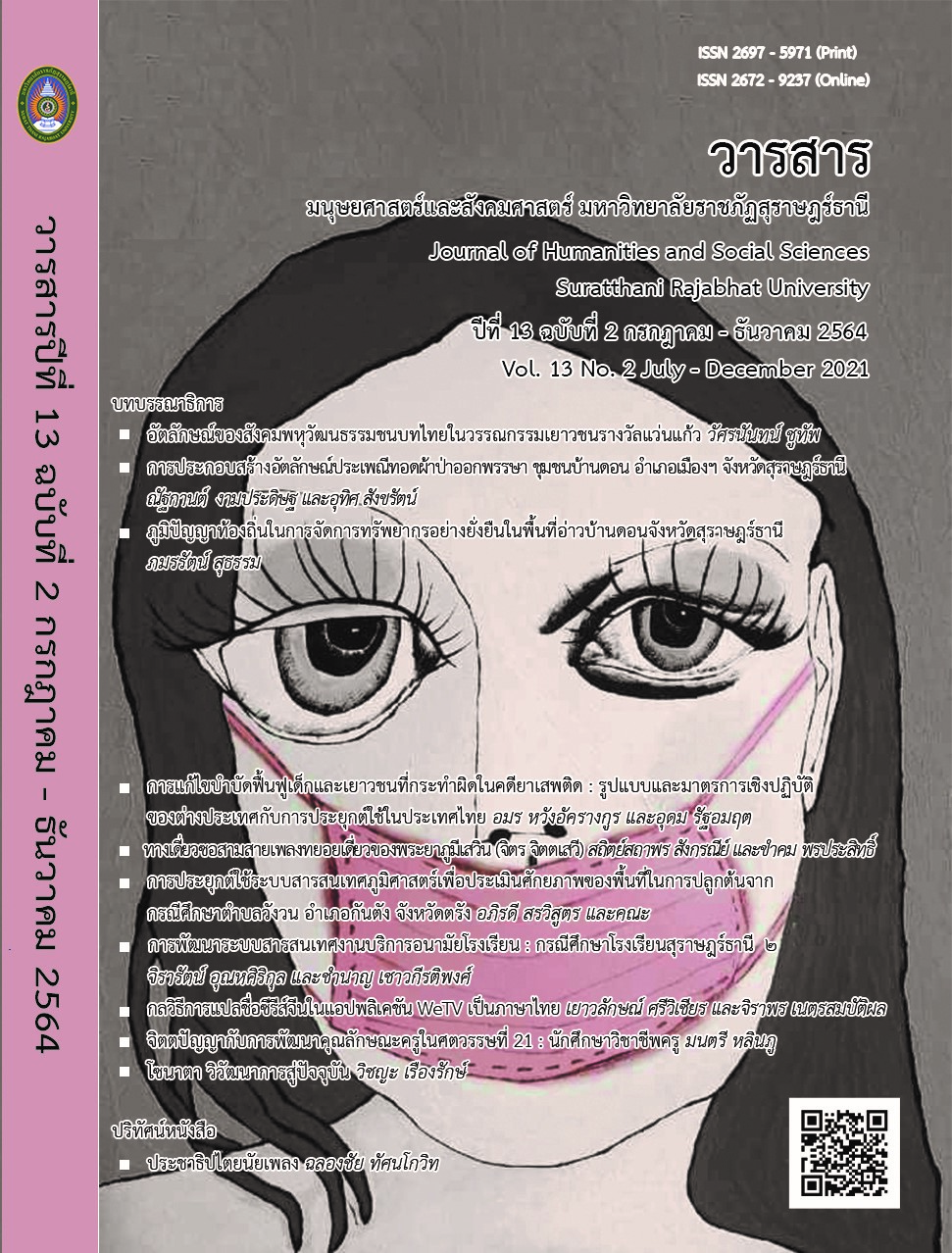Assembling the Culture Identity of the Robes Offering Traditional on The End of Buddhist Lent Day in Ban Don Community, Mueang District, Suratthani Province
Main Article Content
Abstract
The objectives of this research were to study the cultural
identity-building of the Buddhist Lent ceremony in the Ban Don community, Muang District, Surat Thani Province. Using qualitative research methods Data was collected fromin-depth interviews. The researcher used
non-participating observations in the traditional ceremony of Buddhist Lent Day in Suratthani, then analyzed the data from the study. Take theinformation that has been categorized. Examine, decipher, interpret,synthesize, and draw conclusions as study results.
The findings of the study revealed that the identity of the Buddhist Lent Day tradition in Ban Don. It was created from the meaningful assembly to the end of the Buddhist Lent Day tradition by using symbolic representations through the pattern of arranging arches, bushes, and jungle cloth with the introduction of banana trees or branches to embroider with variousmonarchs. Before the end of Buddhist Lent Day, in front of the house by referring to Phutthachatak's history all the way to the end of Buddhist Lent frying events, which is a one-of-a-kind food that is distinct from others, resulting in cultural significance, Due to Ban Don's unique forested forest tradition, the community's economy and income will grow. เป็น As a result, the community earns income from cultural tourism due to the tradition of robe that has the unique identity of the Ban Don community.
Article Details

This work is licensed under a Creative Commons Attribution-NonCommercial-NoDerivatives 4.0 International License.
All published manuscripts have been verified by peer-peer professors in the fields of humanities and social sciences. Reprinting of the article must be authorized by the editorial staff.
References
ฉลาดชาย รมิตตานนท์. (2545). แนวคิดในการศึกษาอัตลักษณ์ความเป็นไท. กรุงเทพฯ:
มหาวิทยาลัยเทคโนโลยีพระจอมเกล้าธนบุรี.
ภาพิมล สีไหม, และเสรี พิจิตรศิริ. (2554). การส่งเสริมประเพณีชักพระของเทศบาล
ตำบลวัดประดู่. วารสารการบริหารท้องถิ่น. 4(4), 59.
สัญญา สัญญาวิวัฒน์. (2550). ทฤษฏีทางสังคมวิทยาเนื้อหาและแนวการใช้ประโยชน์
เบื้องต้น (พิมพ์ครั้งที่ 10). กรุงเทพฯ: สำนักพิมพ์แห่งจุฬาลงกรณ์มหาวิทยาลัย.
สมเกียรติ ภูมิศิริไพบูลย์. (2541). ศึกษาการทำเรือพระในจังหวัดสงขลา. วิทยานิพนธ์
ศิลปศาสตรมหาบัณฑิต วิชาเอกไทยคดีศึกษา. สงขลา: มหาวิทยาลัยทักษิณ.
สำนักงานวัฒนธรรมจังหวัดสุราษฏร์ธานี. (2557). ประเพณีชักพระจังหวัด
สุราษฎร์ธานี. [ออนไลน์]. เข้าได้ถึงจาก http://www.suratthani-culture.
htm. [2562, ตุลาคม 5].
อภิญญา เฟื่องฟูสกุล. (2546). อัตลักษณ์ (Identity) การทบทวนทฤษฎีและกรอบแนวคิด.
กรุงเทพฯ: สำนักงานคณะกรรมการวิจัยแห่งชาติ.
บุคลานุกรม
ณัฎฐณิชา ประจง (ผู้ให้สัมภาษณ์) ณัฐกานต์ งามประดิษฐ (ผู้สัมภาษณ์). ณ หน้าโรงเรียน
สุราษฎร์ธานี ถนนดอนนก ตำบลตลาด อำเภอเมืองฯ จังหวัดสุราษฎร์ธานี.
เมื่อวันที่ 8 ตุลาคม 2562.
นิภา จันทร์แก้ว (ผู้ให้สัมภาษณ์) ณัฐกานต์ งามประดิษฐ (ผู้สัมภาษณ์). ณ บริเวณสะพาน นริศ อำเภอเมืองฯ จังหวัดสุราษฎร์ธานี. เมื่อวันที่ 8 ตุลาคม 2562.
ปฏิชญะ ศรีสมบัติ (ผู้ให้สัมภาษณ์) ณัฐกานต์ งามประดิษฐ (ผู้สัมภาษณ์). ณ บริเวณตลาดล่าง
อำเภอเมืองฯ จังหวัดสุราษฎร์ธานี. เมื่อวันที่ 10 ตุลาคม 2562.
ปริญดา มาเอียด (ผู้ให้สัมภาษณ์) ณัฐกานต์ งามประดิษฐ (ผู้สัมภาษณ์). ณ หน้าโรงเรียน
สุราษฎร์ธานี ถนนดอนนก ตำบลตลาด อำเภอเมืองฯ จังหวัดสุราษฎร์ธานี.
เมื่อวันที่ 8 ตุลาคม 2562.
พระอาจารย์ปิยะ สุขเกษม (ผู้ให้สัมภาษณ์) ณัฐกานต์ งามประดิษฐ (ผู้สัมภาษณ์).
ณ วัดโพธิปักษ์ ตำบลวัดประดู่ อำเภอเมืองฯ จังหวัดสุราษฎร์ธานี. เมื่อวันที่11
ตุลาคม 2562.
เพ็ญศรี กิตตินัดดากุล (ผู้ให้สัมภาษณ์) ณัฐกานต์ งามประดิษฐ (ผู้สัมภาษณ์). ณ บริเวณ
ตลาดล่าง อำเภอเมืองฯ จังหวัดสุราษฎร์ธานี. เมื่อวันที่10 ตุลาคม 2562.


